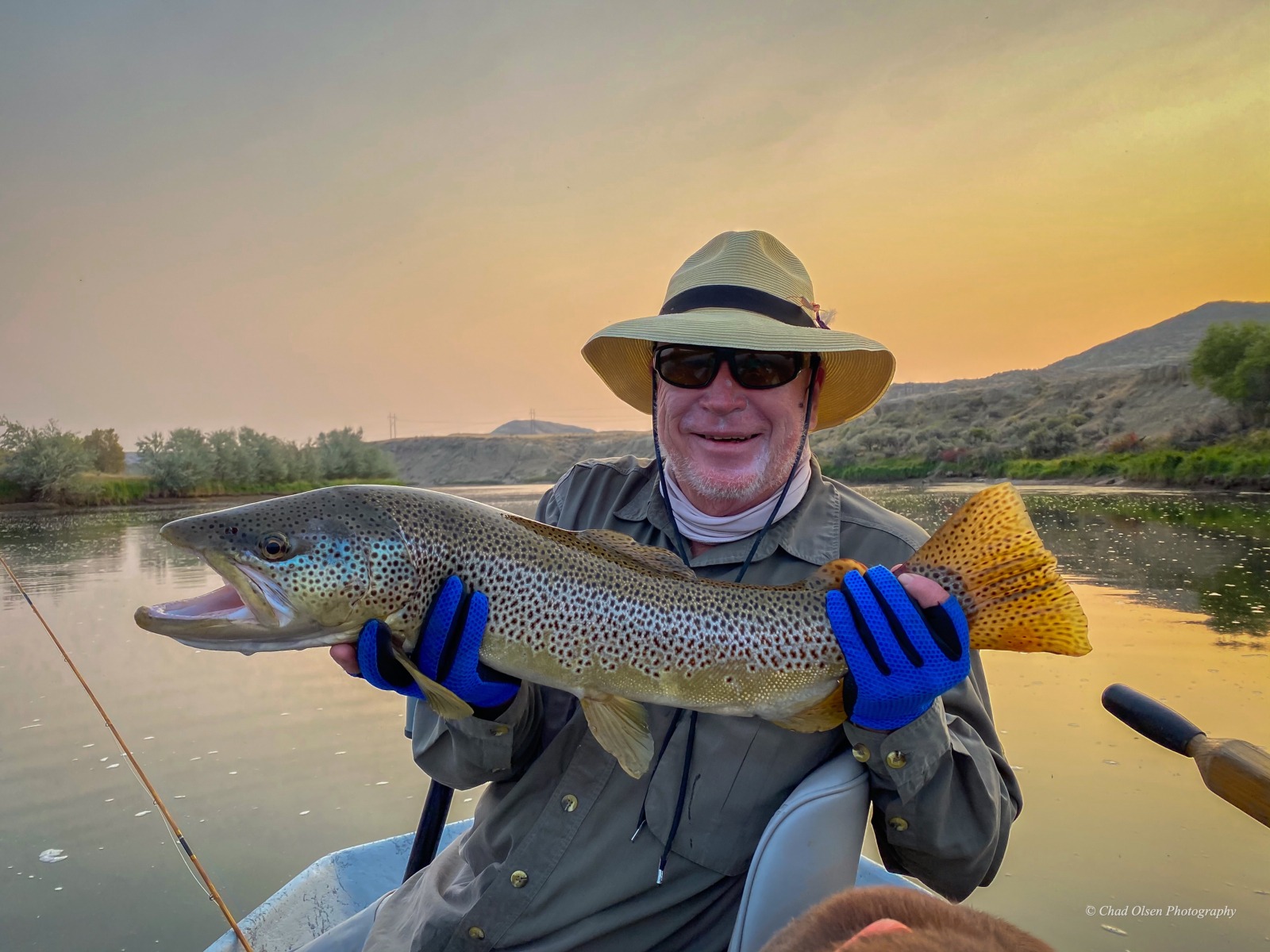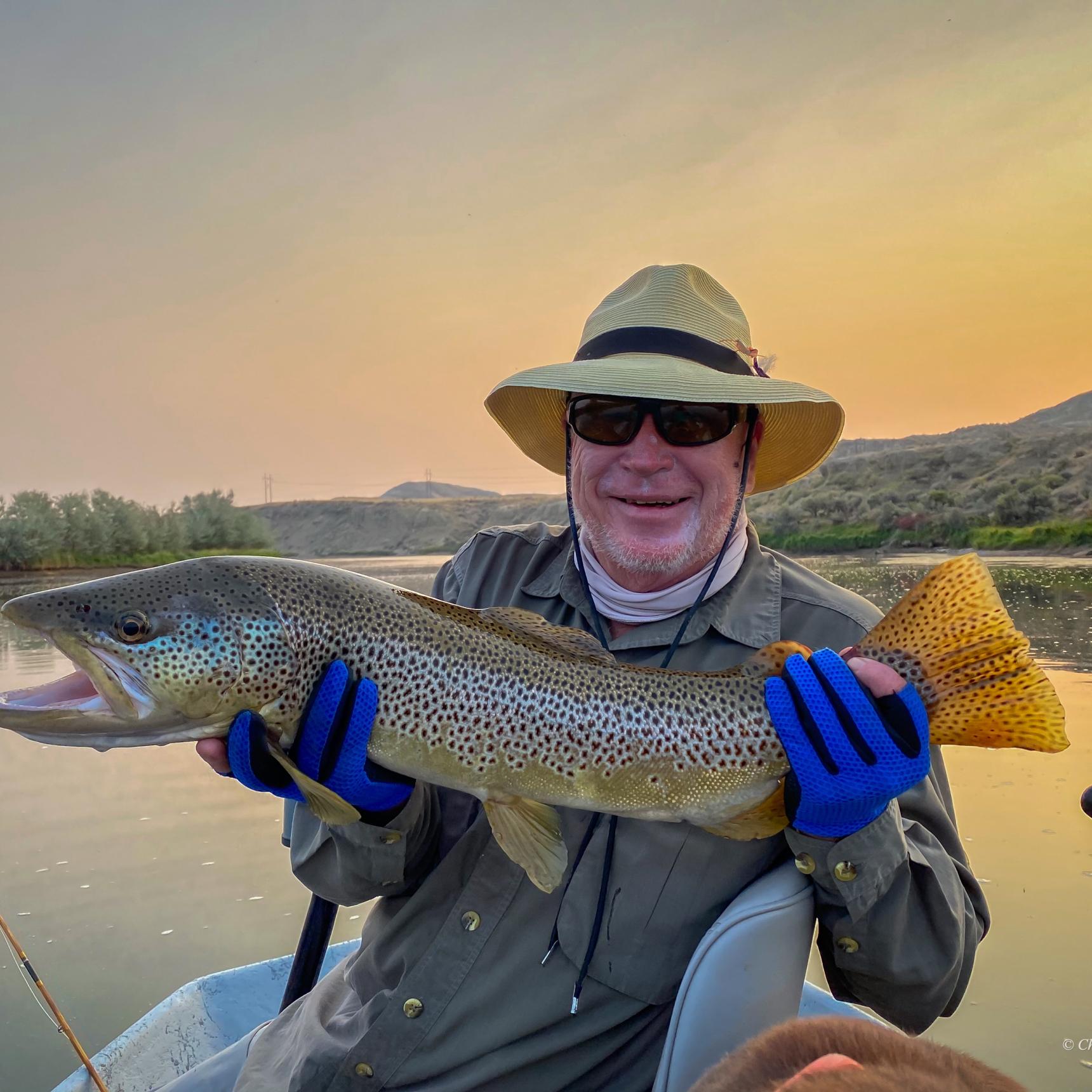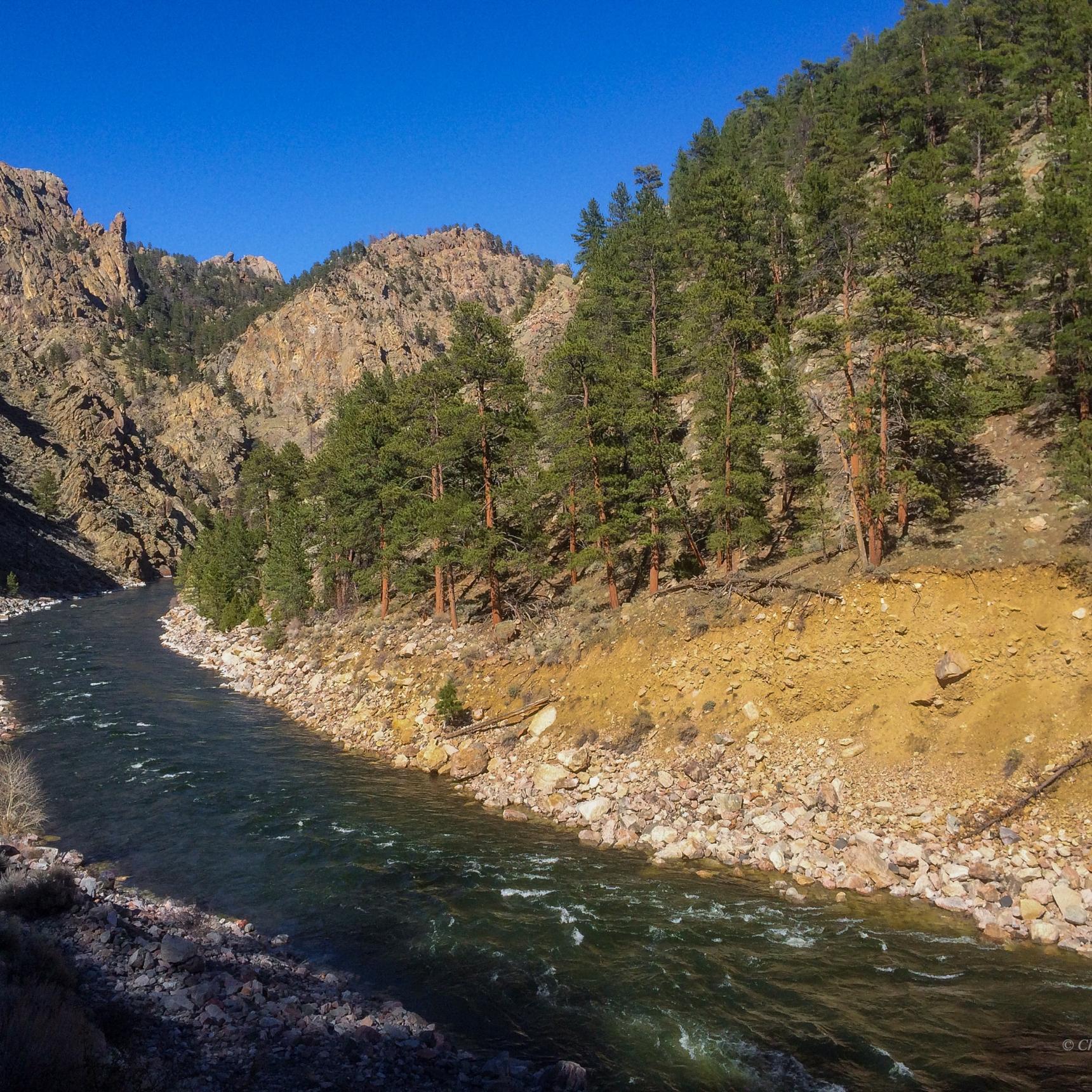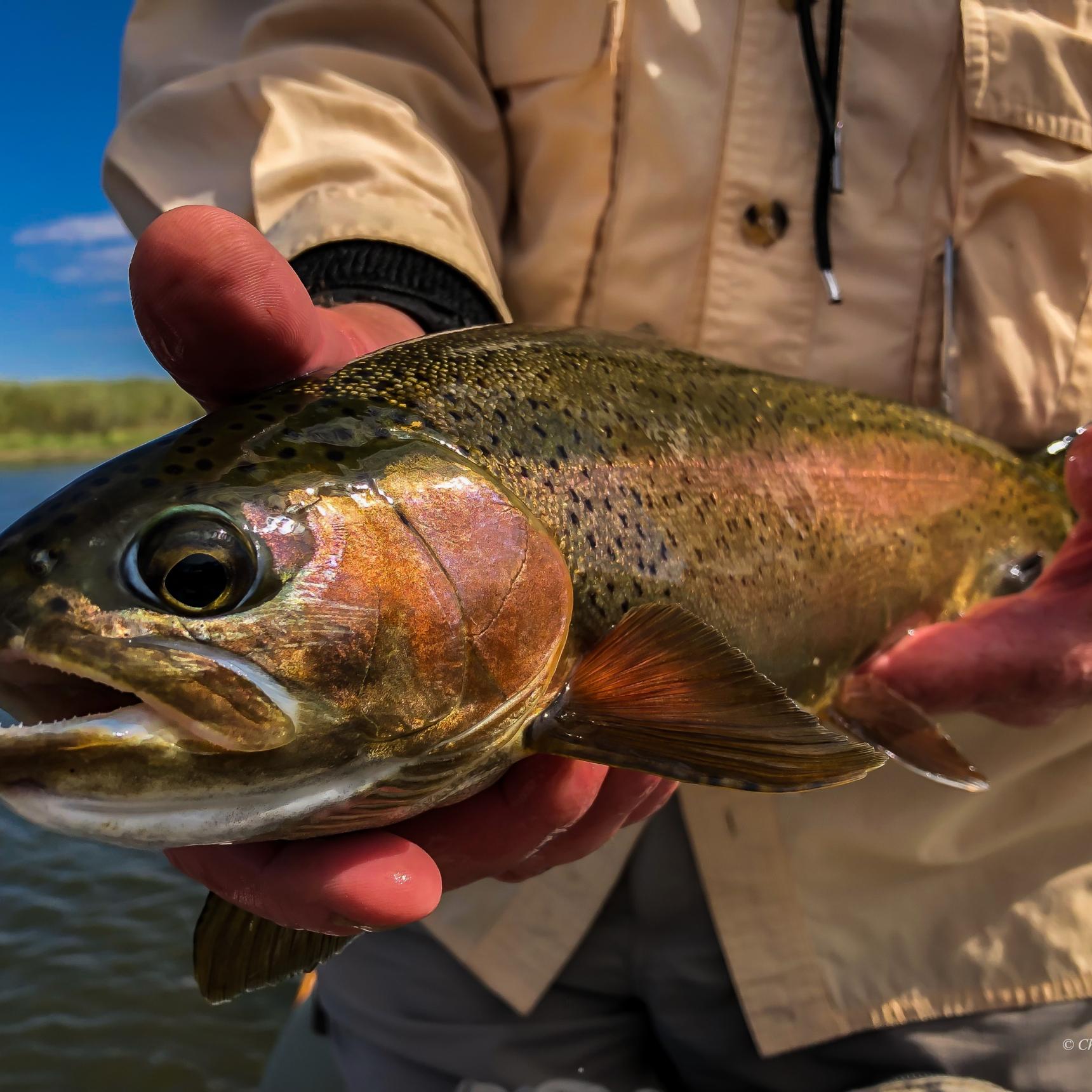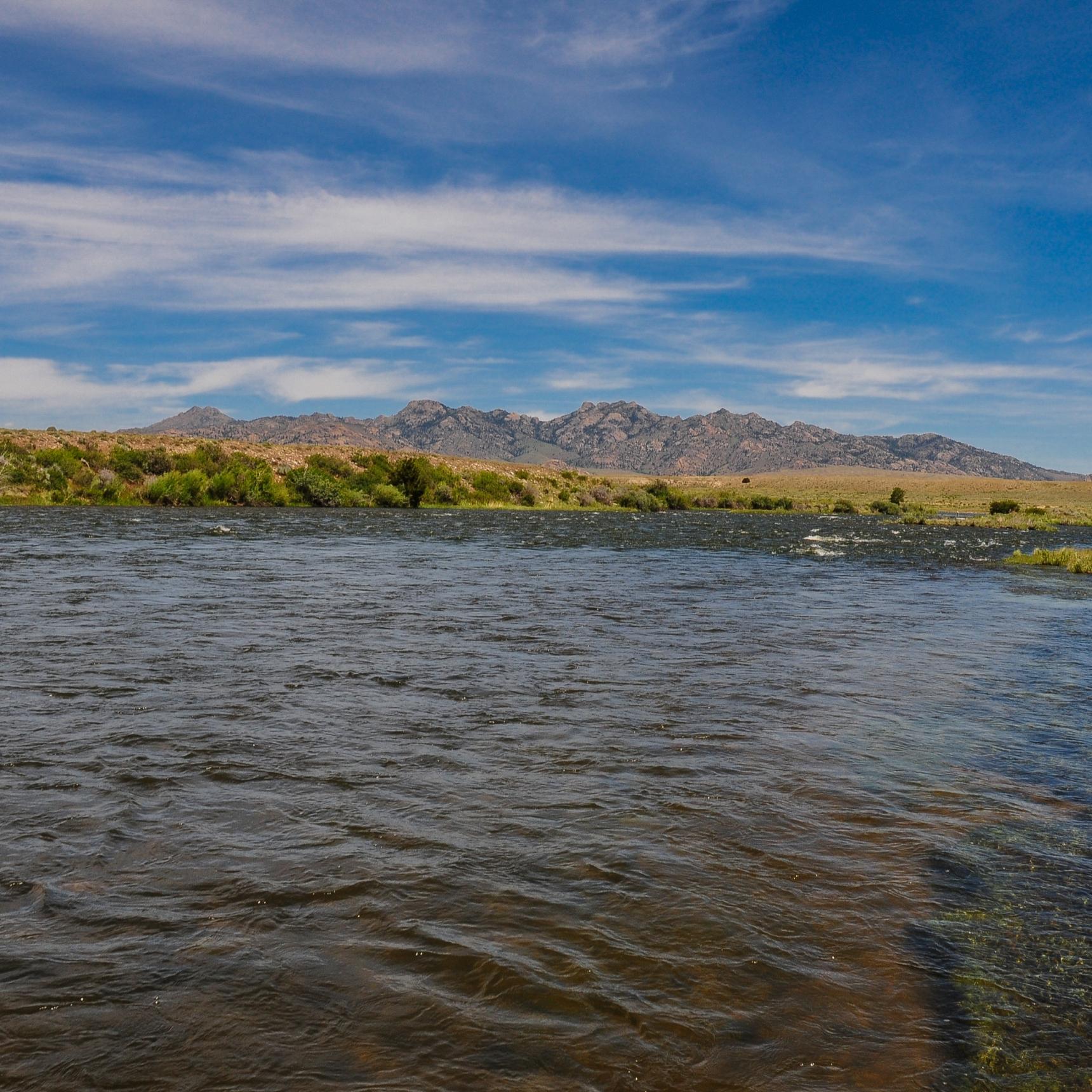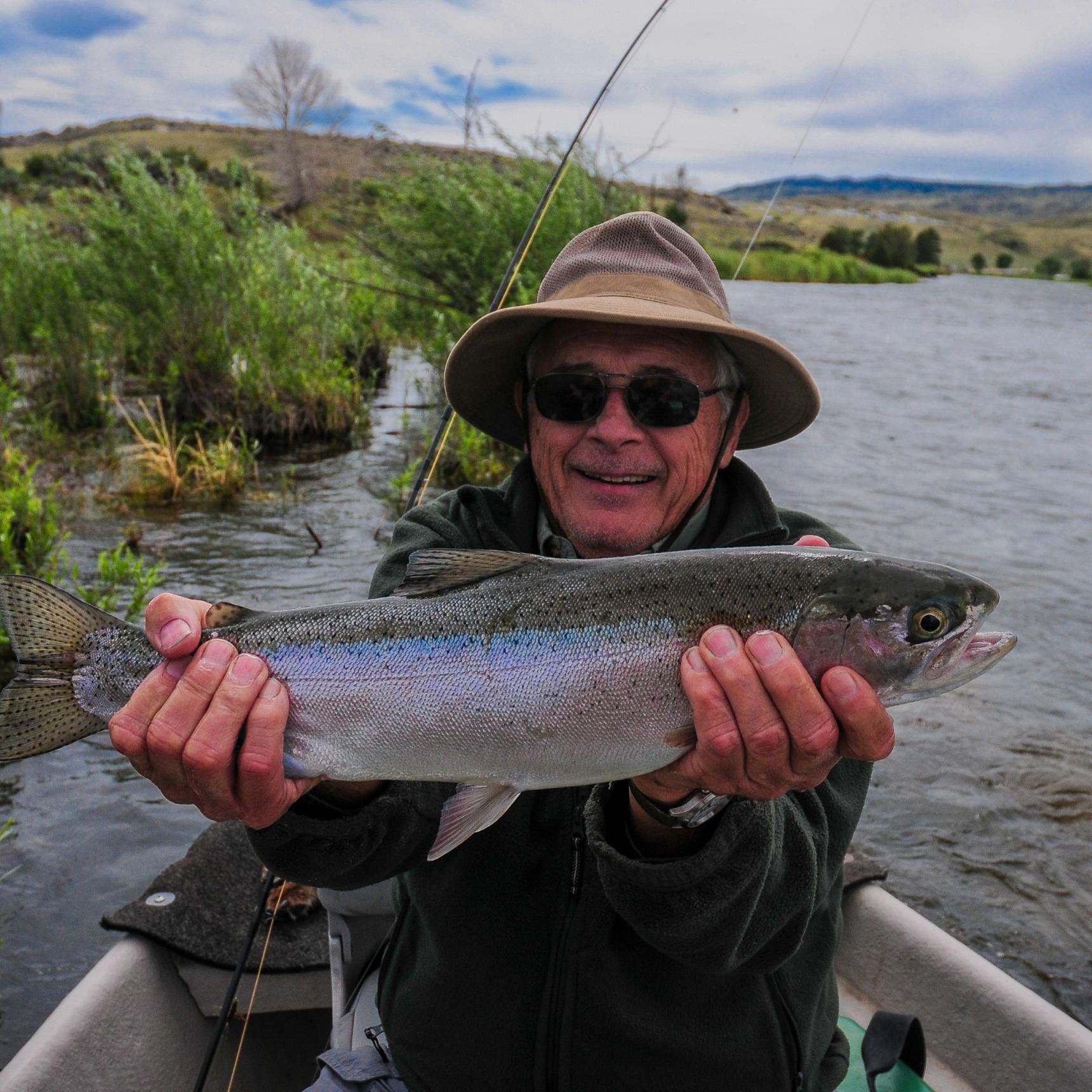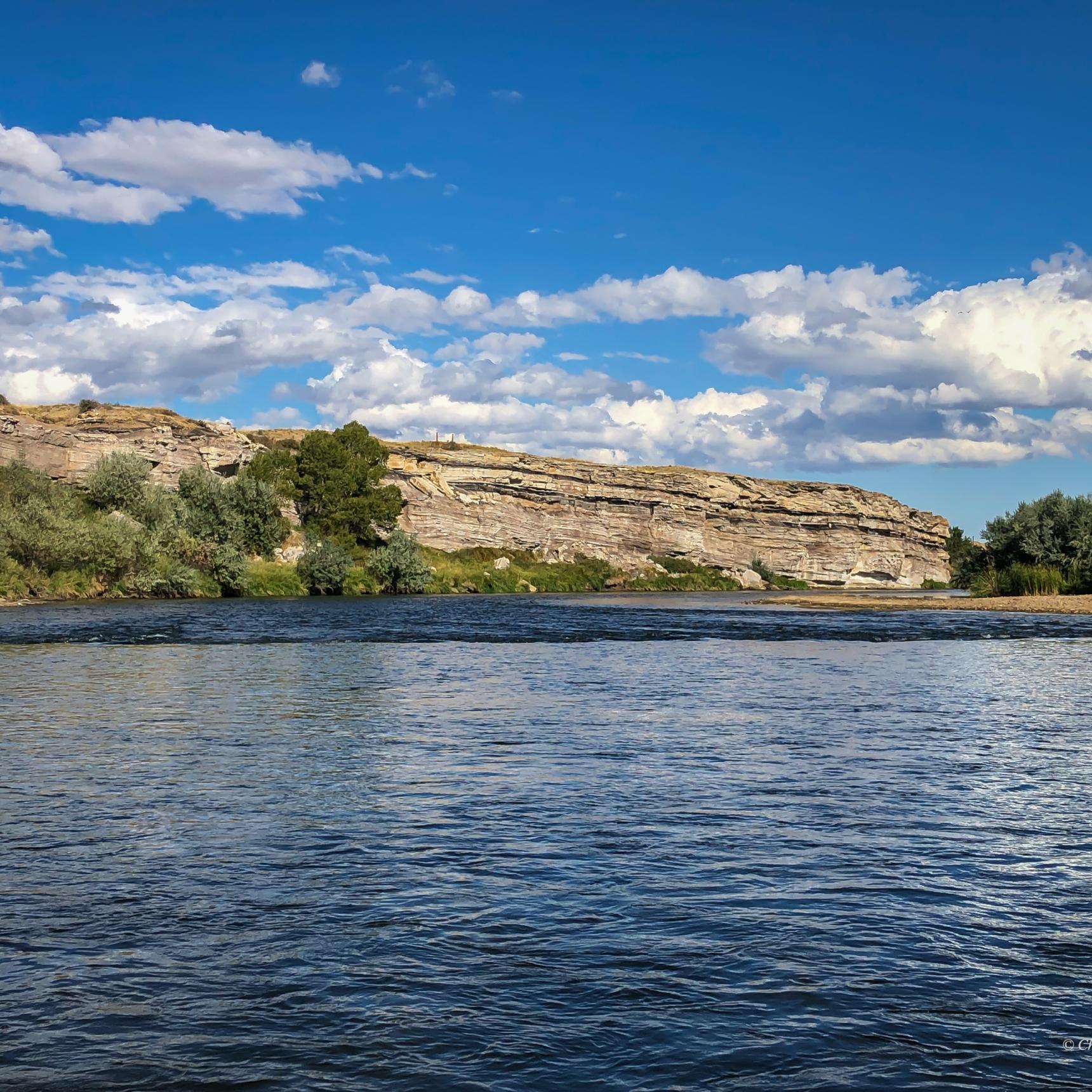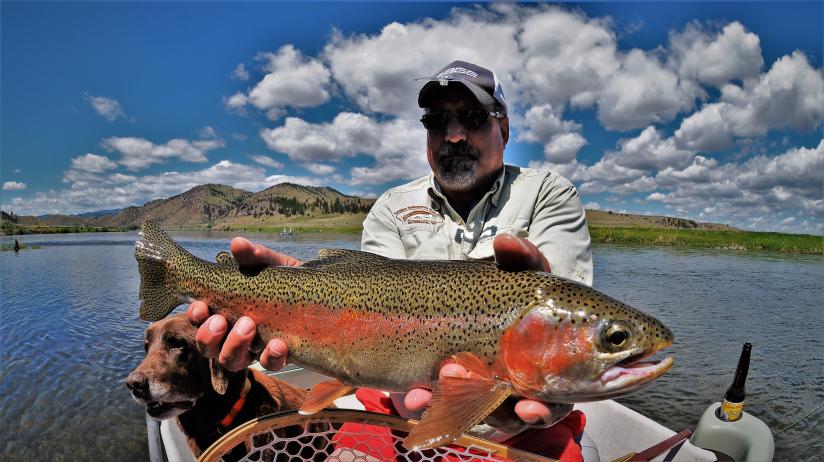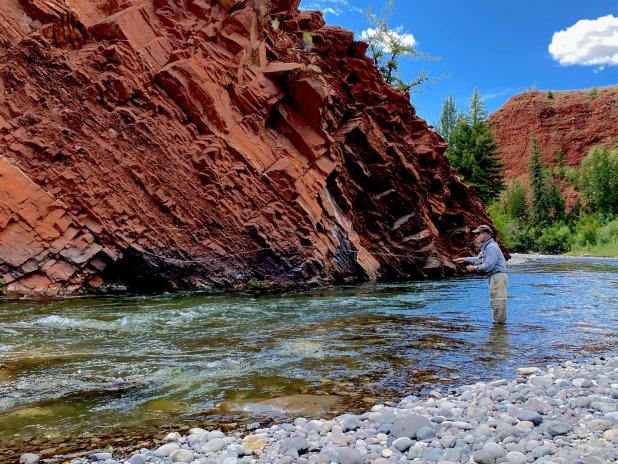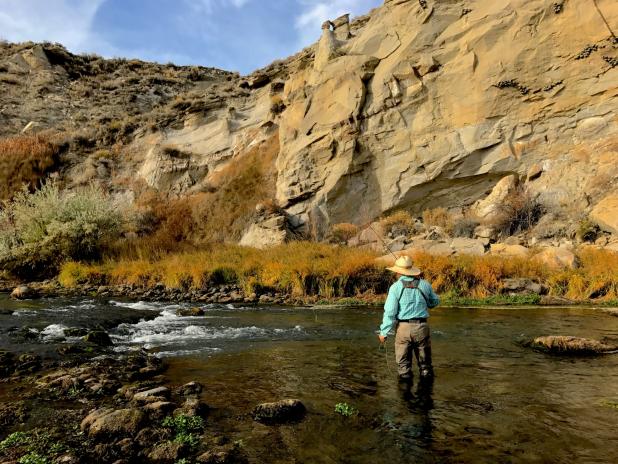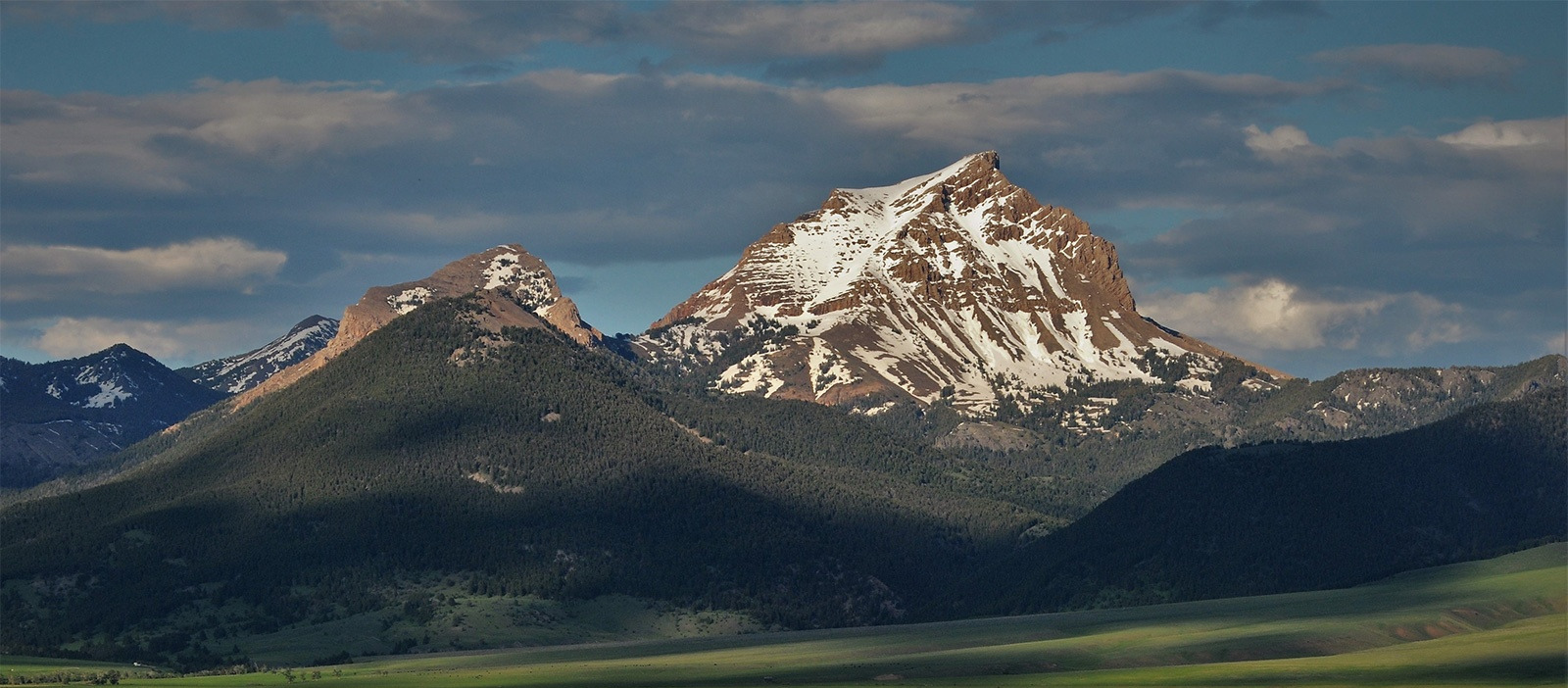North Platte Tailwaters
From the early 1900s to 1961, the Bureau of Reclamation built a series of five dams designed for irrigation purposes and hydroelectric generation. In turn, these dams also created recreational opportunities and rich tailwater fisheries. The reservoirs inundate canyons carved by the river eons ago through the Seminoe and Pedro Mountains and Chugwater formation.
Miracle Mile
The North Platte flows through the Hanna Basin into Seminoe Reservoir north of Interstate 80 in south-central Wyoming. The Bureau of Reclamation dammed Black Canyon with Seminoe Dam, completed in 1939, where the river cut through the Seminoe Mountains. Two miles downstream, Kortes Dam was completed in 1951. Between Kortes Dam and Pathfinder Reservoir, the river flows through the famed “Miracle Mile” section, named by Curt Gowdy for its incredible fishing for big trout. The river actually flows five to eight miles from Kortes Dam to Pathfinder Reservoir; the length varies depending on the lake’s level.
Immediately below Kortes Dam, the river surges through the tight confines of Black Canyon or Seminoe Canyon past vertical granite, quartz sandstone walls, and talus slopes adorn with pines, firs, junipers, and rabbitbrush. Above the Seminoe Road bridge, the river is lined with willows and rocky outcrops with swift pocket-water, riffles, runs, occasional deep holes, and side channels. This stretch has freestone qualities more than tailwater traits due to its swift currents and rocky substrate, making for slippery wading conditions. And it fishes like a freestone with stonefly nymphs, rubber legs, and streamers working well.
The river slows from the bridge to the lake with occasional rocky drops and riffles leading into long, deep runs and pools. This lower stretch fishes like a tailwater with rock worms, scuds, San Juan worms, chironomids, and small midge and mayfly nymphs. The topography opens up as the river flows through an arid basin covered in Wyoming big sagebrush, rabbitbrush, prickly pear cactus, and yucca, with junipers sprinkled throughout and willows lining the river’s edge in places. Dramatic views of the Seminoe Mountains greet the eyes to the south and the Pedro Mountains to the northeast, where a Native American anencephalic infant mummy from the 1700s was discovered in 1932 by gold prospectors. Mule deer and antelope frequent the river bottom and uplands, and coyotes hunt for Richardson ground squirrels.
At times, the “Mile” holds over 3,000 fish per mile, but fish frequently move around this section, running back and forth from Pathfinder Reservoir. It’s a fickle section of the river with varying results. One day can be red hot, and the next can be stone cold. There are resident trout and large lake-run browns and rainbows, with occasional Snake River cutthroats and cutbow hybrids. The Miracle Mile is more about the quality of the fish size rather than quantity. An average day may see ten to twelve trout landed in the boat from 16” to 22” in the two to four-pound class. Good days will see many more landed and fish in the four to the six-pound range are not uncommon, with trophy browns and rainbows exceeding eight pounds a possibility.
Fishing is best in late spring to early summer and again in the fall. Hardy anglers strip and swing streamers or drift nymphs deep from November through February, searching for trophy browns. Nymphing and streamers are the best methods on the “Mile,” though June and July often provide good dry fly fishing with hatches of golden stones, yellow sallies, caddis, and pale morning duns.
The roads are rough, and the silty soils become impassable when wet. You’ll need a vehicle to follow your guide and run your own shuttle or pay a steep price to find someone to help with a shuttle. This section has fewer trout than other portions of the river, but trophy size trout are possible. The scenery, freestone nature of the river, and remoteness make fly fishing on the Miracle Mile a unique experience.
Fremont Canyon
The North Platte empties into Pathfinder Reservoir after flowing through the Miracle Mile. Pathfinder Dam was the first dam constructed in the North Platte Basin, completed in 1909 under the Bureau of Reclamation. The dam was built in “Big Canyon” downstream of the confluence of the North Platte and Sweetwater Rivers, between the granitic rocks of the Pedro and Granite Mountains. In 1958 an 18 feet diameter tunnel was constructed from Pathfinder Dam three miles to the Fremont Canyon Powerplant at the southern end of Alcova Reservoir, diverting all the river’s water through the tunnel, leaving the native channel virtually dry. What was once a raging whitewater canyon was reduced to a trickle. On a group expedition in 1842, explorer Lt. John C. Fremont, nicknamed “the Great Pathfinder,” ran the canyon, only to capsize in one of the canyon’s rocky falls.
Immediately below Pathfinder Dam, the river flows through a gorge of vertical tannish-pink granite walls rising hundreds of feet above. A quarter-mile later, the river emerges from the canyon, flowing under a footbridge into the open Cardwell meadow section, where the river flows for three-quarters of a mile before plummeting into the depths of Fremont Canyon. The country is surrounded by granite rock and limestone formations with junipers, sagebrush, and rabbitbrush.
In 1997, a low-flow outlet was completed on the dam allowing a minimum stream flow of 72 CFS in the four-mile section between the dam and Alcova Reservoir, a cooperative effort between the Wyoming Game & Fish, Wyoming Fly Casters, and Bureau of Reclamation. In the early 2000s, the streambed was reconstructed to accommodate low flows and improve trout habitat, and private land was acquired in an easement and turned into the Cardwell public access.
These conservation efforts have resulted in a prospering tailwater fishery. The river is small and easily fished on foot, where anglers can sight fish with small midge and mayfly nymphs, scuds and rock worms to rainbows, and occasional browns and cutthroats averaging 16” to 20”. Some absolute pigs are spotted and occasionally landed here. Easily accessible and wadeable at Cardwell, the North Platte, a small stream in this reach, gets pressured. To escape the crowds, adventurous anglers can climb into the depths of Fremont Canyon to fish its green, abysmal holes.
Alcova Dam Tailwater
In the 1890s, the Alcova Hot Springs Company had plans to develop Alcova Hot Springs into a thriving health resort near the town of Alcova. Due to financial difficulties, their vision was never realized. The town of Alcova was established as a stage stop and settlement between Muddy Gap and Casper. In 1938, the Bureau of Reclamation completed Alcova Dam, flooding Alcova Canyon and all but remnants of Alcova Hot Springs, which are still active at the dam’s base. Most hot springs were plugged during dam construction, and water from the hot springs heats the power plant today.
The river cuts through Ten Sleep sandstone, limestone formations, and the brilliant red rock Chugwater formation. Junipers, sagebrush, rabbitbrush, and Indian paintbrush grow in this scenic little valley. The river only flows for about a mile and a half before entering Grey Reef Reservoir. This short tailwater section provides excellent fishing for 16” to 20” rainbows using tiny midges, mayflies, and red chironomids, locally called “rock worms,” that flow from the reservoir. Wade fishing is possible here, and full-day float trips are provided by our Wyoming fly fishing guides.
Alcova is now a sleepy fishing settlement, home to Sloane’s General Store and the Sunset Grill dive bar.
Grey Reef
In 1961, the Bureau of Reclamation constructed Grey Reef Dam as an afterbay dam to regulate the fluctuating water flows from hydroelectric generation upstream at Alcova Dam and powerplant. Named after the nearby Grey Reef formation, this world-renowned section of the North Platte holds over 3,000 trout per mile.
The trout population consists primarily of rainbows with occasional browns, cutthroats, and cutbows averaging 15” to 20”. Trophy browns and rainbows exceeding two feet are always a possibility. Trout gorge on tiny midge and mayfly nymphs and rock worms year-round. The river is best fished from a boat, and nymphing produces good numbers of feisty rainbows. While nymphing deep runs, drifting leeches, and stripping streamers, anglers may tie into a kype-jawed brown trout of a lifetime, as browns between 24” and 30” have become increasingly common in recent years.
Pale morning duns, caddis, and yellow sallies hatch in June and July, and blizzard hatches of tricos occur in August and early September. Hoppers and craneflies also bring large trout to the surface in summer and early fall, and hatches of Baetis provide good dry fly fishing at times in the fall.
Silty washes can muddy the river from snowmelt and rainfall in the spring, but the upper river generally remains fishable. And the wind can BLOW, especially in the spring and fall.
Located in the high sagebrush plains of central Wyoming near Casper, this nutrient-rich tailwater fishery provides stable flows and water temperatures, creating ideal trout conditions. The river makes sweeping bends with slow currents dropping over shallow riffles into long runs, deep holes, gliding tailouts, and fishy side channels. As cattle and sheep graze nearby fields, the river lazily meanders past hayfields, sagebrush hills, chalky bluffs, and coulees. Russian olives, willows, and occasional cottonwood trees provide cover along riverbanks. Antelope and mule deer are frequently seen, and golden eagles launch from cliff-hanging nests, searching for prey in the sagebrush flats. Views of the Shirley Basin, Laramie Mountains, and Casper Mountain surround the river.
Government Bridge to Casper
From Government Bridge to Casper, the river has good fishing for rainbows in the 14” to 18” class and trophy browns. Nymphing runs and riffles consistently produce results on the North Platte while drifting dry/dropper combinations in summer and fall are effective. This section generally offers better dry fly fishing with good caddis hatches, yellow sallies, pale morning duns, and tricos during the summer. Hoppers, terrestrials, and craneflies work well from late July to mid-September. Baetis hatches provide good surface action in the fall. Crawfish patterns twitched over weeds beds, leeches and streamers worked through holes and along riverside structures often get the attention of husky rainbows and browns. The lower river may get muddy from rain showers and snowmelt in the spring.
The river drifts past gray shale cliffs, cottonwood stands, Russian olives, and willows with beautiful views of unique geological formations and nearby mountains, while mule deer frequent the juniper hills. The river flows through The Narrows between Bessemer and Casper Mountains and then around Bessemer Bend into Casper.
Casper to Glenrock
Fishing through Casper is surprisingly good, stripping streamers for brown trout, drifting nymphs through riffles and runs, matching hatches, or searching with attractors and terrestrials. From Casper to the Dave Johnston Power Plant just east of Glenrock, the North Platte flows through high sagebrush plains and cottonwood river bottoms. The river splits around grassy islands and drifts by shores lined with Russian olives and intermittent overhanging sandstone bluffs. Dry fly fishing can be good at times, especially during the fall Baetis hatch when pods of big rainbows gulp down duns. Running nymphs through riffles and runs works well, and long, slow stretches are best fished with streamers for rainbows and big browns.
Required Licenses & Fees
Upper North Platte River
The entire North Platte watershed, including the Sweetwater and Encampment Rivers, was historically barren of native cutthroat trout. Trout stocking occurred in the late 1800s and early 1900s, and trout quickly spread throughout the watershed. Today, the river from North Gate Canyon to Saratoga is a Blue Ribbon fishery supporting over 2,000 wild rainbows, browns, and cutthroat trout per mile.
In the spring and fall, hatches of Baetis provide good dry fly fishing. In June, salmonflies hatch in North Gate Canyon, and as runoff subsides in mid to late June, golden stones, yellow sallies, pale morning duns, caddis, green and gray drakes hatch, bringing large trout to the surface. Tricos hatch from late July to early September, spinning like clouds of smoke above streamside vegetation.
Match hatches casting dries to rising trout in riffles, runs, and along banks, or to pods of rising trout in deep holes, foam back eddies, and slow slicks. Search the river’s currents with attractors and dry/dropper combinations or toss hoppers and terrestrials along grassy banks. Strip streamers and leeches, twitch yuk bugs and JJ Specials, drift buggers and rubber legs along fallen trees, and structured banks for trout in the 14” to 18” class. The population decreases further downstream, but hook-jawed trophy browns can reward patient anglers swinging streamers through tailouts or chucking articulated streamers to banks.
The North Platte is formed by the confluence of Grizzly and Little Grizzly Creeks in North Park near Walden, Colorado, flowing nearly 700 miles to its confluence with the South Platte in Nebraska, where the two form the Platte River. Several mountain ranges encircle North Park and the Saratoga Valley. The Never Summer Mountains and Rabbit Ears Range rise to the south, the Medicine Bow and Rawah Mountains tower to the east, and the Park Range and the Sierra Madre soar to the west. The Canadian, Illinois, and Michigan Rivers feed the North Platte as it winds by hayfields and willow thickets through North Park before entering North Gate Canyon just south of Wyoming.
Reaching Wyoming, the North Platte flows through the Platte River Wilderness in the rugged North Gate Canyon. The river surges over numerous Class II to IV rapids such as Cowpie, Narrow Falls, Tootsie Roll, and Stovepipe. Bald eagles and red-tailed hawks screech overhead as moose, elk, mule deer, and black bears roam forested slopes, open meadows, and riverbanks. Bighorn sheep traverse crags and spiraled granite rock outcroppings while beavers and otters swim currents amid huge boulders.
Below Sixmile Gap, the river gradient eases, rolling over a few moderate rapids. The Medicine Bow foothills are a mixture of grassy, sagebrush, and shrub-covered hillsides and benches alternating with forests of limber pines, Douglas firs, aspens, and junipers. The river supports a healthy population of wild rainbows and browns in the canyon, containing shallow riffles, granite riddled boulder gardens, pocket water, deep runs, and holes.
Our float trips begin below Douglas Creek, utilizing various boat ramps with our BLM permits. From Douglas Creek to Bennett Peak, the river flows by the Beaver Creek Hills through open, arid canyon country fringed with remote rangeland and sagebrush hillsides, mixed with junipers, shrubs, and intermittent north-facing forested slopes. The river comprises boulder-strewn pocket water, riffles leading into runs, deep scarped holes, and long, gliding flats.
After drifting west past Bennett Peak, Brush Creek spills into the river, where it exits the canyon into Saratoga Valley and Wyoming ranch country. The river flows past cottonwoods, willowed banks, fertile hay meadows, gravel bars, and sandstone bluffs. Panoramas of the Sierra Madres to the west and the Medicine Bow Mountains to the east rise above the valley floor. The Encampment River merges with the North Platte from the southwest near the town of Encampment. The river braids around Treasure Island and numerous lush river bottom islands on its journey to the town of Saratoga. Moose browse wetlands, mule deer frequent shrubby juniper hills, bald eagles, and ospreys fish the river’s pools. The river dances over riffles into long runs, glassy flats, and tailouts, with sweeping bends, grassy undercuts, rocky cliffs, and downed timber providing trout havens.
Hot springs enter the river at Saratoga, adding minerals and nutrients to the river. Below the town, the river branches around islands, running through cottonwood galleries, carving sandstone bluffs and meandering some 70 miles to Seminoe Reservoir through harshly arid, high desert plains and sagebrush shrublands of the Hanna Basin. The lower river is characterized by curving bend holes, oxbows, grassy banks, side channels, abysmal cliff holes, riffles, gliding runs, and long slow stretches.
Encampment River
The Encampment River is a small freestone river flowing from the Mount Zirkel Wilderness on the east side of the Continental Divide in Colorado. Tributaries from the Park Range and Sierra Madres feed the river in Wyoming as it flows through a rugged canyon in the Encampment River Wilderness. It then winds through cottonwood-shaded bottomlands near Encampment, Wyoming, before flowing through Rainbow Canyon into the North Platte above Treasure Island. The float season on the Encampment is short, and fishing is best as runoff subsides in mid to late June. Salmonflies, golden stones, yellow sallies, caddis, green and grey drakes, and tricos provide exceptional dry fly fishing for beautiful rainbows and browns in the 14” to 18” class. Riffles, runs, sweeping bends with log jams, pocket-water, and rocky cliffs create excellent trout habitats which hold some monsters. The Encampment River is a dry fly angler’s paradise!
Casper
Casper is a booming energy town located in central Wyoming with a population of over 59,000. There’s no shortage of things to do in and around Casper.
Casper hosts prominent rodeo events annually, such as the College National Finals Rodeo in June, PRCA’s Central Wyoming Fair & Rodeo in July, and the PRCA’s Tribute to the American Cowboy rodeo during November. Other events include the Indian Relay Races, River Fest, Beartrap Summer Festival, Harmony, Hops & Hope, and Casper Balloon Roundup Festival, featuring impressive and colorful hot air balloons.
Casper offers a wide range of dining options, live music and concerts, performing arts, and nightlife. Sample cocktails at Backwards Distilling Company and enjoy craft beers at several local breweries. Browse art galleries and downtown shops, and pick up your western wear at the Cadillac Cowgirl, Mustard Seed, or Lou Taubert Ranch Outfitters.
Miles of hiking trails are located along the North Platte River in town and on Casper Mountain. Take scenic drives to Casper Mountain, Alcova Reservoir, Freemont Canyon, Pathfinder Reservoir, the Miracle Mile, Seminoe Dam, and Reservoir. Drive west along the Sweetwater River following the route of the historic California, Mormon, and Oregon trails, and visit iconic landmarks like Independence Rock, Devils Gate, and Pony Express Trail cabins.
Check out the numerous museums in the area, including the National Historic Trails Interpretive Center and the Mormon Handcart Historic Site & Visitor Center west of town.
Non-anglers often enjoy tagging along, taking in the action, scenery, photographing, reading a book, and relaxing. Combine a trip in the fall, hunting for mule deer, antelope, and elk. There are more antelope in Wyoming than people!
Guests often plan several extra days to enjoy other activities and explore the area in combination with their fishing trip. After your North Platte Fly Fishing Vacation, you may head west to visit Grand Teton and Yellowstone National Parks or drive north to visit Devil’s Tower National Monument, the Black Hills, Mount Rushmore, and Badlands National Park.
Saratoga
The town of Saratoga in the beautiful Saratoga Valley, at 6,791 feet, has a population of around 1,600 residents. It’s known for its superb fishing, hunting, outdoor recreational activities, and hot springs.
Surrounded by the Snowy Mountain Range, Elk Mountain, and the Sierra Madre Mountains, hundreds of miles of hiking trails are available to explore in the Medicine Bow-Routt National Forest. Hike the Encampment River Trail, Continental Divide Trail, or take short hikes to the Indian Bathtubs and Lake Marie Falls. Cycle lightly traveled roads, rent a UTV, or mountain bike backcountry roads. Enjoy day horseback rides or scenic floats with an outfitter, or take scenic drives over the Snowy Range Scenic Byway or the Battle Pass Scenic Byway. Guests may extend their trip and visit nearby Rocky Mountain National Park or Dinosaur National Monument in Colorado.
Browse Saratoga’s museums, shops, and art galleries. Take soothing soaks in the Hobo Hot Springs pools or stay at the Saratoga Hot Springs Resort, where you can soak in teepee-covered pools of varying temperatures. Saratoga hosts various events throughout the year, including the Woodchopper’s Jamboree & Rodeo in June and the Steinley Cup Microbrew Festival in August.
Reserving Your Fly Fishing Vacation
We recommend booking your Wyoming fly fishing vacation well in advance to ensure the best guides and accommodations. Guides and accommodations may be hard to reserve on short notice. A 50% deposit is required to finalize your Wyoming fly fishing vacation reservations. Please read the Terms and Conditions for complete details.
Arrival & Ground Transportation
Upon arrival, your guide will pick you up, or ground transfers will take you to your accommodations. You may also choose to rent a vehicle. Having independent transportation allows more flexibility and freedom during your trip.
Trip Expectations
We recommend arriving the day before your fishing begins. Upon arrival, you may purchase any last-minute provisions and settle into your accommodations. Relax, explore the town and local area, enjoy your favorite beverages and appetizers at a local saloon, and dine at one of the many excellent restaurants.
Each day, after coffee and a delicious breakfast, you will make final preparations and drive to your fishing destination, where you will enjoy an exciting day of fishing and adventure. Most fishing locations are within an hour of your lodging, though some can be further. Expect to spend six to eight hours on the water fishing, taking in the scenery, watching wildlife, photographing, trading jokes, and having a great time. Tasty lunches with non-alcoholic beverages are served on the water daily; feel free to bring any alcoholic beverages of your choice.
After a full day of fishing and adventure, return to your comfortable accommodations, perhaps stopping at a favorite watering hole on the way back. Back at your accommodations, clean up with a refreshing shower, relax and enjoy apres fishing.
Then head out for some regional craft beers and cocktails at a western saloon. Indulge in a juicy ribeye steak, grab an elk burger, or enjoy a healthy salad for dinner. Wrap your day up with a nightcap and live music before settling in for a rejuvenating night’s rest.
Rinse and repeat daily as you see fit.
Meals
You may choose to stay at all-inclusive lodges or guest ranches, or you may sample local cafes and restaurants. Foodservice and beverage gratuities are included in all-inclusive package rates. You may prefer Fishing & Lodging only packages; meals and alcoholic beverages are not included.
Lunch, Snacks & Beverages
Shore lunches, snacks, and non-alcoholic beverages are provided each day.
Alcohol
Alcoholic beverages are included with meals in all-inclusive packages. Expensive wines and alcoholic purchases exceeding $100 per day will be billed to the client. All alcoholic beverages apart from meals are the responsibility of clients.
Since we do not have the proper licenses, we cannot provide alcoholic beverages for you during the trip, except when purchased from licensed establishments such as restaurants and bars. You may purchase alcohol to bring with you on the water and during your trip.
Cell Service & Internet
Many towns and locations in Wyoming have good cell phone reception. Other locations have spotty reception or no reception at all. Cell service is often spotty while driving due to the mountainous terrain, rolling hills, draws, and river bottoms.
Wireless internet connectivity is available in many locations and accommodations. Some accommodations do not have cell service or internet connectivity. Be sure to notify people of your potential unavailability and take care of all personal and business tasks beforehand.
Lodging Details
Sleeping Arrangements
Please let us know your lodging preferences for your customized Wyoming Fly Fishing Vacation. Depending on availability, we may book the following accommodations for you.
- All-Inclusive Lodges
- Private Vacation Rentals
- Cabins and Cottages
- Bed & Breakfasts
- Secluded Guest Ranches
- Historic Hotels
*Rates may increase for upgraded premium lodging facilities and services.
Recommended Airports
Once you have confirmed your trip with us, you’ll want to make flight reservations as soon as possible.
Casper Airport
For trips on the North Platte near Casper, we recommend flying into Casper-Natrona County International Airport (CPR).
Drive Times To and From Casper, Wyoming
Casper 15 Minutes
Billings 4 Hours
Denver 4 Hours
Served by Delta Airlines and United Airlines.
Saratoga Airports
For Saratoga, we recommend flying into Laramie Regional Airport (LAR),
Casper-Natrona County International Airport (CPR), or Cheyenne Regional Airport (CYS).
You may also fly into Rock Springs, Wyoming (RKS) or Denver International Airport (DEN).
Casper-Natrona County International Airport (CPR), or Cheyenne Regional Airport (CYS).
You may also fly into Rock Springs, Wyoming (RKS) or Denver International Airport (DEN).
*Transportation is only provided if flying into Casper, Wyoming.
Private aircraft may fly into the Saratoga Jet Center at Shively Field (KSAA).
Drive Times To and From Saratoga, Wyoming
Laramie 1 hour, 25 minutes
Rock Springs 2 hours 15 minutes
Cheyenne 2 hours, 20 minutes
Casper 2 hours, 25 minutes
Denver 3 hours, 50 minutes
Served by United Express Operated by Sky West Airlines.
Served by Delta Airlines and United Airlines.
Served by United Airlines
Southwest Wyoming Regional Airport - Rock Springs
Served by United Express Operated by Sky West Airlines.
Served by Alaska, Allegiant, American, Delta, Frontier, Jet Blue, Southwest, and United Airlines.
Also served by numerous smaller carriers and international airlines.
Also served by numerous smaller carriers and international airlines.
Ground Transportation
Depending on your itinerary and preferences, your guide(s) may pick you up at the airport. You may rent a vehicle for greater flexibility and freedom during your trip. Car rental companies are available at your arrival airport. We will work with you to finalize transportation details at booking.
*For Saratoga Trips, transportation is only provided if flying into Casper, Wyoming.
**River shuttles may not be available on some sections of the North Platte and Encampment Rivers. We may recommend renting a vehicle to help run shuttles, depending on your itinerary.
Departure Details
Please book departing airline reservations for the day after your trip ends. We may book accommodations with shuttle services to your departing airport. Your guide(s) may drop you off at the airport, depending on your itinerary.
All-Inclusive Fly Fishing Vacation Rates
4 Nights/3 Days5 Nights/4 Days6 Nights/5 Days7 Nights/6 Days
$3,395/person $4,295/person$5,195/person$6,095/person
Fishing & Lodging Only Fly Fishing Vacation Rates
4 Nights/3 Days5 Nights/4 Days6 Nights/5 Days7 Nights/6 Days
$2,595/person $3,295/person$3,995/person$4,695/person
- Rates based on 2 anglers/guide, double occupancy
- Contact us for Single Angler Supplement Rates
- Rates may increase for upgraded premium lodging facilities and services
- Additional fees may be charged for private chefs and caterers
- Fishing & Lodging Only Rates Do Not Include Transportation, Meals or Alcoholic Beverages
Payment Options
A 50% deposit is required to finalize your reservation and is due within 10 days of booking your trip. We will invoice you by email, and upon receiving your invoice, you can choose to pay using the online ACH payment option. This option is a quick and convenient way to pay your trip deposit and finalize your reservation.
Payment reminders will be sent by email for open invoices with remaining balances due, which can be paid using the ACH option.
Deposits and final payments can be paid with bank wire transfers, credit cards, or mailing checks payable to Greater Yellowstone Flyfishing Outfitters. A 3.5 % convenience fee is assessed for all credit card transactions. Please contact us if you prefer cash or other payment forms.
Greater Yellowstone Flyfishing Outfitters Payment Options
· ACH Online Payments – U.S. financial institutions and bank accounts only
· Personal & Business Checks* - U.S. financial institutions and bank accounts only
· Electronic Wire Payments - wiring fees are the responsibility of the client
· Credit Cards – 3.5% Convenience Fee applied
· Cash
· International Payments can be made via wire or with a credit card.
*Client will be billed all associated costs for returned checks. The client will have 7 days to reimburse Greater Yellowstone Flyfishing Outfitters for returned check costs and provide an alternative form of payment; otherwise, trip reservations will be cancelled, and all deposits and payments will be forfeited. Included
- Accommodations
- Transportation & Airport Pick Up and Drop Off*
- All Meals, Snacks, Appetizers & Associated Gratuities**
- Alcoholic Beverages with Meals**
- Lunch, Snacks & Non-Alcoholic Beverages on the river**
- Fishing Guides – 2 Anglers/Guide
- Flies & Terminal Tackle
- Rods & Reels – If Needed
- River Shuttles
Not Included
- Airline Flights
- Rental Car (Optional)*
- Additional lodging and meals beyond your scheduled trip
- Upgraded Premium Lodging
- Private Chefs
- Catering
- Fishing Licenses
- Gratuities for Fishing Guides, Private Ground Transfers
- Rental Waders & Boots - If Needed
- Personal Expenses & Incidentals
- Personal Items – See Gear List PDFs Below
- Park Entrance Fees
*We may arrange private ground transfers between the airport and your accommodations. You may also rent a vehicle for greater flexibility and freedom during your trip. Transportation is not included in Fishing & Lodging Only rates. We will work with you to finalize transportation details at booking.
**All meals, snacks, appetizers, alcoholic beverages with meals, and associated gratuities are included in all-inclusive packages. Meals, appetizers, and alcoholic beverages are not included in Fishing & Lodging Only packages. Alcoholic beverages are not included on the river, but you may bring your own.
Our guides work very hard to ensure an enjoyable trip, and we encourage you to tip accordingly. Fly Fishing Vacations and Road Trips require significant time, additional work, and numerous logistics by your guide, which go well beyond a typical day trip. We suggest an appropriate gratuity from $150-$200/day/guide for these reasons. However, an excellent day of fishing, a memorable event, or extra effort on the guide's behalf may deserve more. Please consider that our guides work harder when fishing is slow or during adverse weather. Cash gratuities should be given directly to your guide upon finishing multi-day trips.
Many variables beyond our control, such as weather, wind, barometric pressure, water temperatures, and fish behavior, influence the day's fishing. While fishing is a highlight of your trip, there are numerous ways to enjoy your fly fishing vacation. Please align your expectations with the conditions and your abilities. No expectations, no disappointments!
Clients frequently invite guides for drinks or dinner after fishing. Socializing is a great way to celebrate the day's events, plan the next day, and connect. While guides always appreciate the generosity, buying drinks and dinner are not considered part of or in lieu of gratuities. Socializing extends a guide's long and physically demanding day. Time is required before and after each day's trip for preparing, organizing, and cleaning.
Please let us know if you have any comments or concerns about your trip.
Trip Insurance
We realize these trips are expensive, and much is at stake financially. For this reason, we highly recommend that you purchase trip insurance in advance. Unforeseen circumstances arise, and travel insurance is very reasonable should you have to cancel your trip for any reason. We recommend Travel Guard Travel Insurance and Global Rescue Insurance to protect your financial investment, which may cover trip cancellations for any reason. For more information or to purchase Trip Insurance, please visit Travel Guard or Global Rescue.
To receive complete coverage options and benefits, be sure to purchase travel insurance within 15 days of paying your deposit.
Medical Evacuation Insurance
We recommend Global Rescue’s worldwide medical evacuation and extraction services if you become ill or injured during your trip or due to natural disaster, COVID-19, and other reasons. Due to the remote nature of many of our trips, potential challenges receiving immediate professional medical help, and limited cell coverage, we highly recommend purchasing medical evacuation insurance along with your trip insurance.
For more information or to purchase Medical Evacuation Insurance, please visit Global Rescue.

